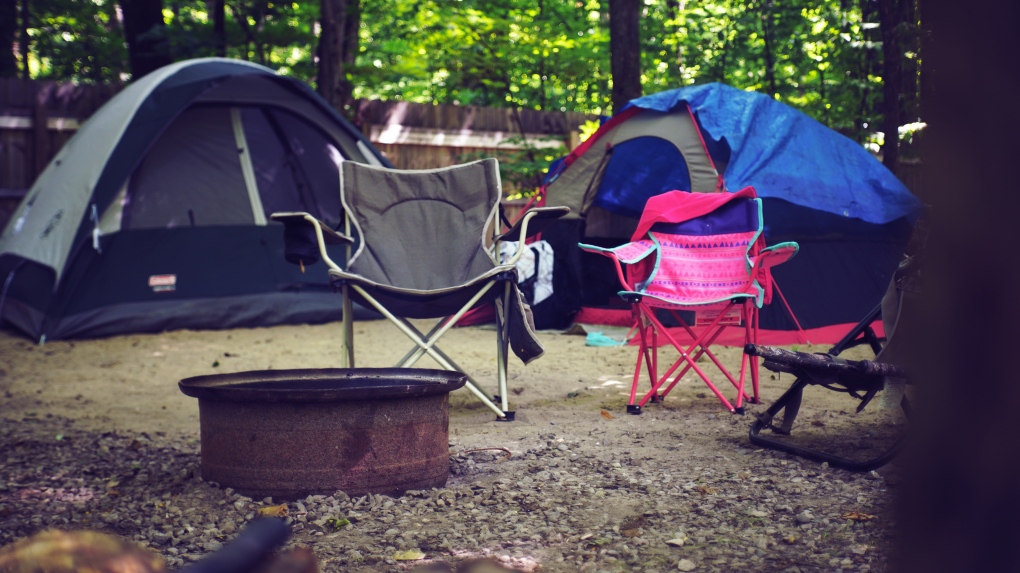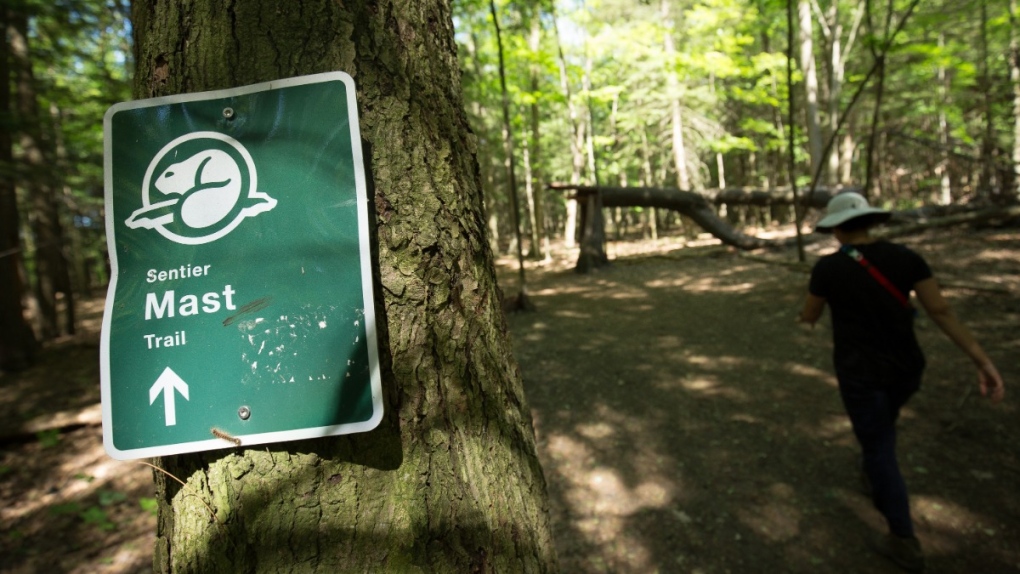Ontario's second new provincial park will 'definitively' include backcountry, minister says
 A backcountry campsite is pictured in this 2010 file photo. (The Canadian Press)
A backcountry campsite is pictured in this 2010 file photo. (The Canadian Press)
Ontario will soon be announcing the creation of a second new provincial park with backcountry camping availability, something experts hope will add new protected land rather than repurpose already conserved properties.
Few details have been publicly released about the second provincial park, which the government committed to in both the 2022 and 2023 budget.
In the latest budget, the province said the park would offer “four-season facilities” and add 250 campsites to the Ontario Parks system.
There will be space for swimming, hiking and cross-country skiing, the budget outlined.
Piccini told CTV News Toronto this week it will “definitively” involve backcountry camping. He hinted over the weekend that an announcement could come as early as next month.
“That one will be announced in the very near future.”
- Download our app to get local alerts on your device
- Get the latest local updates right to your inbox
For some experts, this presents an opportunity to protect additional lands in Ontario and help Canada reach its conservation goal of protecting 30 per cent of land by 2030.
As it stands, officials say about 10.9 per cent of the land in Ontario is considered protected.
“In order for us, for Canada, to achieve those goals, every province and territory needs to play a supporting role,” associate professor at Wilfrid Laurier University Christopher Lemieux said. “Ontario has not committed to anything at this point.”
“There's no strategy in place that includes how and where these new areas are going to be established, and how consultation is going to occur with Indigenous communities, with the broader public in the creation of these new areas.”
Over the weekend, Piccini announced the government would be creating a separate urban provincial park near Uxbridge, Ont.
The park could include up to 532 hectares of provincially-owned land along the Oak Ridges Moraine, in addition to about 598 hectares of Durham Regional Forest and 123 hectares of land from the Town of Uxbridge.
The idea, Piccini told CTV News Toronto earlier this week, would be to integrate the land to provide further recreational opportunities close to the Greater Toronto and Hamilton Area.
Aside from the land considerations, not much is known about the provincial park. Piccini said a feasibility study and consultation process will help determine what other amenities the park will have, including whether residents will be able to camp nearby.
“Do they want new trail systems? Do they want some backcountry? Do they want overnight camping, do they want RV campgrounds…I look forward to hearing that. And then obviously, there'll be important decisions to make on how we pay for that and come together.”
By protecting the under the Provincial Parks and Conservation Reserves Act, Piccini said it will then be counted towards federal environmental commitments.
“All of the lands in question are not governed under that act today,” he said. “If we added that, it will also be submitted to the federal database.”
 Camping chairs are seen in this file photo. (Mac DeStroir/Pexels)
Camping chairs are seen in this file photo. (Mac DeStroir/Pexels)
The Oak Ridges Moraine, however, is generally considered protected from development—although last year the province re-designated some lands within the area as suitable for residential development as part of its pledge to build 1.5 million homes.
The other lands could be considered as new protected areas; although the Durham Regional Forest is already owned and managed by Lake Simcoe Region Conservation Authority.
“It is an interesting case where on the surface, this is great news and absolutely we need more parks and protected areas throughout Ontario,” Daniel Kraus, national conservation director for Wildlife Conservation Society Canada, told CTV News Toronto.
“But when you're taking something that's already been managed for conservation … it's almost more like a relabeling as opposed to a genuine addition to protecting conservation areas in Ontario.”
WHAT IS AN URBAN PARK?
The provincial park set to be located near Uxbridge is considered Ontario’s first urban park, something Piccini defines primarily by its proximity to the town itself.
“It’s in a traditional urbanized setting,” he said, adding it will be the closest provincial park to the Greater Toronto Area (GTA). “It’s three kilometres from the Town of Uxbridge, so we are talking very close. You can walk to it from the town.”
Speaking to reporters over the weekend, Piccini said the government will be reviewing the Provincial Parks and Conservation Reserves Act to add a new classification that would encompass this type of area.
There are six provincial park classifications protected under the existing legislation—wilderness, natural reserve, cultural heritage, natural environment, waterway and recreation.
The classifications help determine what kind of activities and amenities are allowed in the area to meet provincial goals.
The federal government is currently reviewing applications to create multiple urban national parks, including one in Windsor, Ont. The goal of those parks, according to Parks Canada, is to conserve and restore nature within cities.
Canada’s biggest national urban park is Rouge National Urban Park in Scarborough, near the Toronto Zoo.
“It's about really healthy growing communities,” Piccini said.
 Sign marks the Mast trail at the Rouge Urban National Park in Toronto, on June 15, 2021. (Giordano Ciampini / THE CANADIAN PRESS)
Sign marks the Mast trail at the Rouge Urban National Park in Toronto, on June 15, 2021. (Giordano Ciampini / THE CANADIAN PRESS)
Ontario Parks were visited about 12 million times in 2022, the government said, with a large portion of those visitors coming in from the GTA.
“They deserve to have access, equitable access, to the outdoors as well.”
WHERE WILL THE SECOND PARK BE LOCATED?
“We definitely need to create more large protected conserved areas in the north,” Klaus said, while also adding that any kind of protection in southern Ontario where “nature has been impacted the most” is also welcome.
The location of the backcountry provincial park appears to be shrouded in secrecy, with experts hoping the choice will take the area’s biodiversity into account.
The urban park near Uxbridge, which officials say could take up to two years to officially open, is the first operational provincial park to open in 40 years.
Demand for park space has skyrocketed since the pandemic, especially in southern Ontario. Some campers have resorted to mass booking sites, only to cancel them at a later date in order to ensure they get a reservation.
“I think first and foremost, we need to protect places that have high biological diversity, where there's some level of threat,” Kraus said. “The province hasn't really been doing that.”
“I would like to see it kind of go beyond protecting what's already been conserved. So that might mean additional land securement additional restoration of areas.”
Lemieux agreed, but added there is an opportunity through broad consultations with both the general public and Indigenous partners to create a park that will be more inclusive.
“A lot of the campgrounds, for example, in some of our traditional provincial parks … they're really designed around a nuclear family model,” he said.
“We're starting to see a change, a little bit of a change, in the type of visitors who go to provincial parks and there just may be different desires.”
An inclusive design, Lemieux said, could include accessibility for an aging population or people with disabilities, as well as Indigenous perspectives.
CTVNews.ca Top Stories

W5 Investigates Provinces look to Saskatchewan on how to collect millions more for victims of crime
A W5 investigation showed how convicted criminals ordered to pay restitution struggled to do so, and how just $7 million of more than $250 million had been claimed. While many provinces struggle to keep track, Saskatchewan is leading the way in making sure victims get their money.
'Tragic and sudden loss': Toronto police ID officer who died after suspected medical episode while on duty
A police officer who died after having a suspected medical episode on duty was executing a search warrant in connection with an ongoing robbery investigation in North York, Toronto police confirmed Thursday.
Who received the longest jail terms in the Gisele Pelicot rape trial?
A French court found all 51 defendants guilty on Thursday in a mass rape case including Dominique Pelicot, who repeatedly drugged his then wife, Gisele, and allowed dozens of strangers into the family home to rape her.
PM Justin Trudeau planning sizable Friday cabinet shuffle, sources say
Prime Minister Justin Trudeau is planning a sizable cabinet shuffle on Friday, sources confirm to CTV News. The long-awaited reconfiguration of Trudeau's front bench comes amid turmoil for the Liberal government after the shocking resignation of Chrystia Freeland.
The Royal Family spreads holiday cheer with new Christmas cards
The Royal Family is spreading holiday cheer with newly released Christmas cards.
'Theodore Too' refloated after partial sinking in St. Catharines
The life-size replica of Theodore Tugboat, Theodore TOO, is upright again after suffering a partial sinking Tuesday.
Love, excitement and emotional reunions as holiday travel hits its peak
Air Canada alone estimates it will move two million passengers over the holidays, with Dec. 19 to Dec. 23 being the peak period.
Child struck by vehicle south of London has died
According to an online fundraiser organized by a family friend, the boy who was hit by a driver south of London earlier this week has died.
Manitoba man wins $40M Lotto Max jackpot
A Manitoba man has won one of the top five largest lottery jackpots in Manitoba history.

































